South West England
South West England | ||
|---|---|---|
Combined authorities West of England | | |
| Districts |
| |
| Counties | ||
| Government | ||
| • Type | Local authority leaders' board | |
| • Body | South West Councils | |
| • House of Commons | 55 MPs (of 650) | |
| Area | ||
| • Total | 9,415 sq mi (24,385 km2) | |
| • Land | 9,203 sq mi (23,836 km2) | |
| • Water | 5 sq mi (14 km2) | |
| • Rank | 1st | |
| Population (2021)[2] | ||
| • Total | 5,712,840 | |
| • Rank | 6th | |
| • Density | 600/sq mi (240/km2) | |
| Ethnicity (2021) | ||
| • Ethnic groups | ||
| Religion (2021) | ||
| • Religion | List
| |
| GSS code | E12000009 | |
| ITL code | TLK | |
| GVA | 2021 estimate[4] | |
| • Total | £149.8 billion | |
| • Rank | 5th | |
| • Per capita | £26,219 | |
| • Rank | 5th | |
| GDP (nominal) | 2021 estimate[5] | |
| • Total | £169.3 billion | |
| • Rank | 5th | |
| • Per capita | £29,628 | |
| • Rank | 5th | |
South West England, or the South West of England, is one of the nine official regions of England in the United Kingdom. It consists of the counties of Cornwall (including the Isles of Scilly), Dorset, Devon, Gloucestershire, Somerset and Wiltshire. Cities and large towns in the region include Bath, Bristol, Bournemouth, Cheltenham, Exeter, Gloucester, Plymouth and Swindon. It is geographically the largest of the nine regions of England with a land area of 9,203 square miles (23,836 km2), but the third-least populous, with approximately 5.7 million residents.[1][2]
The region includes the
Following the abolition of the South West Regional Assembly in 2008 and Government Office in 2011, South West Councils provide local government coordination in the region. Bristol, South Gloucestershire, and Bath and North East Somerset are part of the West of England Combined Authority.
The region is known for its rich folklore, including the legend of King Arthur and Glastonbury Tor, as well as its traditions and customs. Cornwall has its own language, Cornish, and some regard it as a Celtic nation. The South West is known for Cheddar cheese, which originated in the Somerset village of Cheddar; Devon cream teas, crabs, Cornish pasties, and cider. It is home to the Eden Project, Aardman Animations, the Glastonbury Festival, the Bristol International Balloon Fiesta, trip hop music and Cornwall's surfing beaches. The region has also been home to some of Britain's most renowned writers, including Daphne du Maurier, Agatha Christie and Enid Blyton, all of whom set many of their works here, and the South West is also the location of Thomas Hardy's Wessex, the setting for many of his best-known novels.
Geography
| This article is part of a series within the Politics of the United Kingdom on the |
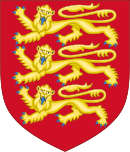 |
|---|

Geology and landscape
Most of the region is located on the South West Peninsula, between the English Channel and Bristol Channel. It has the longest coastline of all the English regions, totalling over 700 miles (1,130 km).[7] Much of the coast is now protected from further substantial development because of its environmental importance, which contributes to the region's attractiveness to tourists and residents.
Geologically the region is divided into the largely igneous and metamorphic west and sedimentary east, the dividing line slightly to the west of the River Exe.[8] Cornwall and West Devon's landscape is of rocky coastline and high moorland, notably at Bodmin Moor and Dartmoor. These are due to the granite and slate that underlie the area. The highest point of the region is High Willhays, at 2,038 feet (621 m), on Dartmoor.[9] In North Devon the slates of the west and limestones of the east meet at Exmoor National Park. The variety of rocks of similar ages seen has led to the county's name being given to that of the Devonian period.
The east of the region is characterised by wide, flat clay
Climate
The climate of South West England is classed as oceanic (Cfb) according to the Köppen climate classification. The oceanic climate typically experiences cool winters with warmer summers and precipitation all year round, with more experienced in winter. Annual rainfall is about 1,000 millimetres (39 in) and up to 2,000 millimetres (79 in) on higher ground.[14] Summer maxima averages range from 18 °C (64 °F) to 22 °C (72 °F) and winter minimum averages range from 1 °C (34 °F) to 4 °C (39 °F) across the south-west.[14] It is the second windiest area of the United Kingdom, the majority of winds coming from the south-west and north-east.[14] Government organisations predict the region to rise in temperature and become the hottest region in the United Kingdom.[15]
Inland areas of low altitude experience the least amount of precipitation. They experience the highest summer maxima temperatures, but winter minima are colder than the coast. Snowfalls are more frequent in comparison to the coast, but less so in comparison to higher ground.[14] It experiences the lowest wind speeds and sunshine total in between that of the coast and the moors. The climate of inland areas is more noticeable the further north-east into the region.
In comparison to inland areas, the coast experiences high minimum temperatures, especially in winter, and it experiences slightly lower maximum temperatures during the summer. Rainfall is the lowest at the coast and snowfall is rarer than the rest of the region. Coastal areas are the windiest parts of the peninsula and they receive the most sunshine. The general coastal climate is more typical the further south-west into the region.
Areas of moorland inland such as: Bodmin Moor, Dartmoor and Exmoor experience lower temperatures and more precipitation than the rest of the southwest (approximately twice as much rainfall as lowland areas), because of their high altitude. Both of these factors also cause it to experience the highest levels of snowfall and the lowest levels of sunshine. Exposed areas of the moors are windier than lowlands and can be almost as windy as the coast.
Regional identity
The boundaries of the South West region are based upon those devised by central government in the 1930s for civil defence administration and subsequently used for various statistical analyses. The region is also similar to that used in the 17th-century Rule of the Major-Generals under Cromwell. (For further information, see Historical and alternative regions of England). By the 1960s, the South West region (including Dorset, which for some previous purposes had been included in a Southern region), was widely recognised for government administration and statistics. The boundaries were carried forward into the 1990s when regional administrations were formally established as Government Office Regions. A regional assembly and regional development agency were created in 1999, then abolished in 2008 and 2012 respectively.
It has been argued[by whom?] that the official South West region does not possess a cultural and historic unity or identity of itself, which has led to criticism of it as an "artificial" construct. The large area of the region, stretching as it does from the Isles of Scilly to Gloucestershire, encompasses diverse areas which have little more in common with each other than they do with other areas of England. The region has several TV stations and newspapers based in different areas, and no single acknowledged regional "capital". Many people in the region have some level of a "South West" or "West Country" regional identity, although this may not necessarily correspond to an identification with the official government-defined region. It is common for people in the region to identify at a national level (whether English, British, Cornish or a county, city or town level). Identifying as being from 'the Westcountry', amorphous though it is, tends to be more predominant further into the peninsula where the status of being from the region is less equivocal.[16][17]
In particular, Cornwall's inclusion in the region is disputed by Cornish nationalists.[18] The cross-party Cornish Constitutional Convention and Cornish nationalist party Mebyon Kernow have campaigned for a Cornish Assembly ever since the idea of regional devolution was put forward.
Settlements
The South West region is largely rural, with small towns and villages; a higher proportion of people live in such areas than in any other English region. There are two major regional cities in terms of population, which are Bristol and Plymouth (although Bristol is larger by some consideration), and two major conurbations which are the South East Dorset Conurbation (Bournemouth, Christchurch and Poole) and the Bristol Metropolitan Conurbation (which includes the City of Bristol and areas of South Gloucestershire).
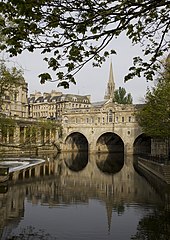
Cities and Towns with specific tourist and cultural sites of interest include Bath, Bristol, Salisbury, Plymouth, Exeter, Cheltenham, Gloucester and Weston-super-Mare, as well as the county of Cornwall on a widespread scale.
The region is home to six universities: University of Bristol, University of The West of England (UWE), University of Exeter, University of Plymouth, Plymouth Marjon University, University of Gloucestershire (Gloucester and Cheltenham), and Falmouth University (Cornwall).

The largest cities and towns in order of population are: Bristol (700,000) Plymouth (300,000) Bournemouth (250,000) Swindon (230,000) Poole (180,000) Gloucester (180,000) Exeter (160,000) Cheltenham (150,000) Torbay (150,000) Bath (130,000) Weston-super-Mare (80,000) Taunton (70,000) Salisbury (50,000) Weymouth (50,000).
The largest conurbations are the area sometimes called Greater Bristol, which includes parts of South Gloucestershire; and the South East Dorset conurbation, covering Bournemouth, Poole and Christchurch.
The population of the South West in 2009 was about five million.[19]
Transport
The region lies on
The vast majority of trains in the region are operated by CrossCountry, Great Western Railway (GWR) and South Western Railway (SWR). GWR is the key operator for all counties in the region except Dorset where SWR is the key operator.
CrossCountry operates services to
Transport for Wales also operates services between Maesteg and Cheltenham Spa. West Midlands Railway operated a parliamentary train between Birmingham New Street and Gloucester via Worcester Shrub Hill, which was withdrawn in 2019 (there was once a regular service on the route, but this was withdrawn in 2009).
It has been proposed that the former
Local bus services are primarily operated by FirstGroup, Go-Ahead Group and Stagecoach subsidiaries as well as independent operators. Megabus and National Express operate long-distance services from South West England to all parts of the United Kingdom.
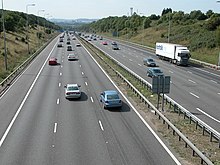
Three major roads enter the region from the east. The M4 motorway from London to South Wales via Bristol is the busiest. The A303 cuts through the centre of the region from Salisbury to Honiton, where it merges with the A30 to continue past Exeter to the west of Cornwall. The A31, an extension of the M27, serves Poole and Bournemouth and the Dorset coast. The M5 runs from the West Midlands through Gloucestershire, Bristol and Somerset to Exeter. The A38 serves as a western extension to Plymouth. There are three other smaller motorways in the region, all in the Bristol area.
Passenger airports in the region include Bristol, Exeter, Newquay and Bournemouth.
Within the region the local transport authorities carry out transport planning through the use of a Local Transport Plan (LTP) which outlines their strategies, policies and implementation programme.[24] The most recent LTP is that for the period 2006–11. In the South West region the following transport authorities have published their LTP online: Bournemouth U.A.,[25] Cornwall U.A.,[26] Devon,[27] Dorset,[28] Gloucestershire,[29] Plymouth U.A.,[30] Somerset,[31] Swindon U. A.,[32] Torbay U. A.[33] and Wiltshire unitary authority.[34] The transport authorities of Bath and North East Somerset U. A., Bristol U. A., North Somerset U. A. and South Gloucestershire U. A. publish a single Joint Local Transport Plan as part of the West of England Partnership.[35]
History
Pre-Roman
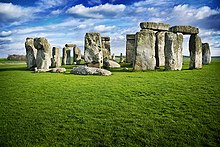
There is evidence from
At the end of the
The region was heavily populated during the Neolithic,
At the time of the
Roman period

During the Roman era, the east of the region, particularly the Cotswolds and eastern Somerset, was heavily Romanised but Devon and Cornwall were much less so, though Exeter was a regional capital. There are villas, farms and temples dating from the period, including the remains at Bath.
The area of
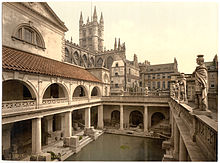
The Roman invasion, and possibly the preceding period of involvement in the internal affairs of the south of England, was inspired in part by the lead mines of the
Excavations carried out before the flooding of
British kingdoms and the arrival of the Saxons
After the Romans left at the start of the 5th century AD, the region split into several Brittonic kingdoms, including
The Anglo-Saxons then gained control of the Cotswold area; but most of Somerset, Dorset and Devon (as well as Cornwall) remained in British hands until the late 7th century. According to the
9th century and the arrival of the Danes
The English defeated a combined Cornish and Danish force at

King Alfred was driven to seek refuge from the Danes at
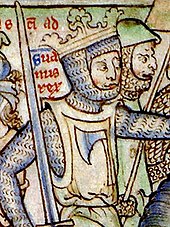
11th century
In the late pre-Norman period, the east coast of modern-day England came under the growing sway of the
Middle Ages

After the Norman Conquest the region was controlled by various Norman as well as
Many parish churches were rebuilt in this period. Between 1107 and 1129

Where conditions were suitable, coastal villages and ports had an economy based on fishing. The larger ports such as

During the
16th century
Great disturbances throughout both Cornwall and Devon followed the introduction of
The
17th century
The
During the

In 1685, the Duke of Monmouth led the Monmouth Rebellion in which a force partly raised in Somerset fought against James II. The rebels landed at Lyme Regis and travelled north hoping to capture Bristol and Bath, Puritan soldiers damaged the west front of Wells Cathedral, tore lead from the roof to make bullets, broke the windows, smashed the organ and the furnishings, and for a time stabled their horses in the nave.[100] They were defeated in the Battle of Sedgemoor at Westonzoyland, the last battle fought on English soil.[101] The Bloody Assizes which followed saw the losers being sentenced to death or transportation.[102] At the time of the Glorious Revolution, King James II gathered his main forces, altogether about 19,000 men, at Salisbury, James himself arriving there on 19 November 1688. The first blood was shed at the Wincanton Skirmish in Somerset. In Salisbury, James heard that some of his officers, such as Edward Hyde, had deserted, and he broke out in a nose-bleed which he took as a bad omen. His commander in chief, the Earl of Feversham, advised retreat on 23 November, and the next day John Churchill deserted to William. On 26 November, James's daughter Princess Anne did the same, and James returned to London the same day, never again to be at the head of a serious military force in England.[103]
Modern history
Since 1650, the City of
The 19th century saw improvements to roads in the region with the introduction of

Around the 1860s, at the height of the iron and steel era, a
During the
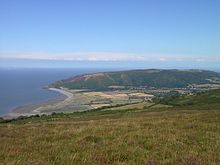
World War II

Much of the Battle of the Beams was carried out at the Telecommunications Research Establishment at Worth Matravers in Dorset; the H2S radar was developed by Sir Bernard Lovell of Bristol. The Gloster Meteor at Newquay Air Museum is the oldest flying jet aircraft in the world. Long Ashton Research Station in Somerset invented Ribena (for population health in World War II) and improved cider.
Scientific heritage
Jan Ingenhousz, the Dutch biologist, discovered photosynthesis in 1779 at Bowood House in Wiltshire; on 1 August 1774, Joseph Priestley discovered oxygen there too. A fossil of the oldest ancestor of the Tyrannosaurus was found in Gloucestershire; Mary Anning was a famous fossil collector from Lyme Regis. Edward Jenner, pioneer of vaccination, was from Gloucestershire.
Industrial heritage
Sir Benjamin Baker from Cheltenham jointly-designed the 1890 Forth Bridge. William Murdoch in 1792 lit his house in Redruth with gas, the first in Britain. Plasticine was invented 1897 in Bath by William Harbutt. Thomas Young of Somerset is known for his double-slit experiment in optics, and in solid mechanics for his famous Young's modulus. Henry Fox Talbot, inventor of a negative-positive process in 1841, from Wiltshire made the first photograph in August 1835; Nicéphore Niépce of France can claim the first photo in 1826; William Friese-Greene of Bristol is thought to be the father of cinematography after inventing his chronophotographic camera in 1889.
Ted Codd, inventor of databases and SQL, was from Poole. Campden BRI at Ebrington in north-east Gloucestershire was an important research centre for canned food; J. S. Fry & Sons of Bristol made world's first chocolate bar in 1847.
The first carpets were made in Britain in 1741 at Wilton, Wiltshire. In 1698, Thomas Savery of Devon developed an early steam engine; Thomas Newcomen from Dartmouth made another early steam engine in 1710. Edward Butler, a farmer from Devon born in Bickington in 1862, invented the petrol engine.
Demographics

At the 2011 census, the proportion of white people in the region fell from 97.7% to 95.4%, with the proportion of black and Asian residents doubling. At that time, 91.8% of the region's residents were classed as White British, which was higher than the England average of 79.8%.[124]
The region had the oldest median age in England; in the 2011 census, West Somerset had the UK's oldest average age – almost 48. The region had the second-highest proportion (23%) of rural population in the UK, after Northern Ireland.
Ethnicity
| Ethnic group | Year | |||||||
|---|---|---|---|---|---|---|---|---|
| 1991[125] | 2001[126] | 2011[127] | 2021[128] | |||||
| Number | % | Number | % | Number | % | Number | % | |
| White: Total | 4,546,848 | 98.6% | 4,815,316 | 97.7% | 5,046,429 | 95.41% | 5,309,608 | 93.1% |
| White: British | – | – | 4,701,602 | 95.39% | 4,855,676 | 91.8% | 5,008,149 | 87.8% |
| White: Irish
|
– | – | 32,484 | 0.65% | 28,616 | 0.54% | 31,698 | 0.6% |
| White: Irish Traveller/Gypsy
|
– | – | – | – | 5,631 | 6,382 | 0.1% | |
| White: Roma | – | – | – | – | – | – | 5,785 | 0.1% |
| White: Other
|
– | – | 81,230 | 1.64% | 156,506 | 2.95% | 257,594 | 4.5% |
Asian or Asian British : Total
|
28,368 | 0.6% | 45,522 | 0.92% | 105,537 | 1.99% | 159,184 | 2.8% |
| Asian or Asian British: Indian
|
10,915 | 16,394 | 34,188 | 58,847 | 1.0% | |||
| Asian or Asian British: Pakistani
|
3,925 | 6,729 | 11,622 | 17,432 | 0.3% | |||
| Asian or Asian British: Bangladeshi
|
2,308 | 4,816 | 8,416 | 12,217 | 0.2% | |||
| Asian or Asian British: Chinese | 6,687 | 12,722 | 22,243 | 26,516 | 0.5% | |||
| Asian or Asian British: Asian Other
|
4,533 | 4,861 | 29,068 | 44,172 | 0.8% | |||
| Black or Black British: Total | 21,779 | 0.5% | 20,920 | 0.42% | 49,476 | 0.93% | 69,614 | 1.3% |
| Black or Black British: African
|
2,820 | 6,171 | 24,226 | 43,318 | 0.8% | |||
| Black or Black British: Caribbean
|
12,387 | 12,405 | 15,129 | 17,226 | 0.3% | |||
| Black or Black British: Other
|
6,572 | 2,344 | 10,121 | 9,070 | 0.2% | |||
| Mixed: Total | – | – | 37,371 | 0.75% | 71,884 | 1.35% | 114,074 | 2% |
| Mixed: Caribbean
|
– | – | 13,343 | 25,669 | 33,217 | 0.6% | ||
| Mixed: African
|
– | – | 3,917 | 8,550 | 15,644 | 0.3% | ||
| Mixed: Asian
|
– | – | 11,198 | 21,410 | 34,960 | 0.6% | ||
| Mixed: Other Mixed
|
– | – | 8,913 | 16,255 | 30,253 | 0.5% | ||
| Other: Total | 12,429 | 0.3% | 9,305 | 0.18% | 15,609 | 0.29% | 48,706 | 0.9% |
| Other: Arab
|
– | – | – | – | 5,692 | 10,302 | 0.2% | |
| Other: Any other ethnic group | 12,429 | 0.3% | 9,305 | 0.18% | 9,917 | 38,404 | 0.7% | |
| Ethnic minority: Total | 62,576 | 1.4% | 113,118 | 2.3% | 242,506 | 4.6% | 391,578 | 6.9% |
| Total | 4,609,424 | 100% | 4,928,434 | 100% | 5,288,935 | 100% | 5,701,186 | 100% |
Housing
35% of people in the region own their homes outright, with no debt, the highest in the UK. The Cotswold district had the biggest house price increases in the region, and the second-biggest in the UK outside of London and the South-East, in a March 2015 survey.
Teenage pregnancy
For top-tier authorities, Torbay has the highest teenage pregnancy rate in the region,
Health
The population in the region with the highest obesity level is Sedgemoor in Somerset, with 73.4%, the fifth in the UK.[citation needed] North Dorset has the lowest proportion of cancer deaths in England – 97 per 100,000 (the England average is 142 per 100,000), down from 162 ten years earlier.[when?]
In the 2011 census, East Dorset had the highest rate of marriage in the UK; East Dorset also has the third-highest life expectancy for men in the UK at 82.7.[citation needed]
Crime
For England and Wales in 2015, Wiltshire has the fourth-lowest crime rate, and Devon and Cornwall has the fifth-lowest.
Deprivation
As measured by the
The least deprived council districts are, in descending order: East Dorset, North Wiltshire, South Gloucestershire, Cotswold, Kennet, Stroud, Tewkesbury, West Wiltshire, Salisbury, and Bath and North East Somerset. At county level, the least deprived areas, in descending order, are South Gloucestershire, Wiltshire, Bath and North East Somerset, Dorset, Gloucestershire, Poole, North Somerset, and Somerset. For smaller areas, the least-deprived in the region are E01015563 (139th in England) – Shaw and Nine Elms ward, in north Swindon; E01014791 (163rd in England) – Portishead East ward, in North Somerset off the A369 in
In March 2011, the region had the second-lowest unemployment claimant count in England, second to South East England, with 2.7%. Inside the region, Torbay has the highest rate with 4.5%, followed by Bristol and Plymouth with 3.8%. East Dorset has the lowest rate with 1.4%.[132]
| Census | Population |
|---|---|
| 1801 | 1,355,811 |
| 1811 | 1,498,569 |
| 1821 | 1,754,725 |
| 1831 | 1,981,488 |
| 1841 | 2,173,157 |
| 1851 | 2,263,070 |
| 1861 | 2,319,593 |
| 1881 | 2,444,167 |
| 1891 | 2,543,186 |
| 1911 | 2,825,046 |
| 1921 | 2,877,866 |
| 1931 | 2,989,977 |
| 1951 | 3,483,675 |
| 1961 | 3,693,029 |
| 1971 | 4,132,770 |
| 1981 | 4,163,729 |
| 1991 | 4,610,241 |
| 2001 | 4,928,364 |
| 2011 | 5,288,935 |
Language
The
Until the 19th century, the
West Country dialects are commonly represented as "
Economy and industry
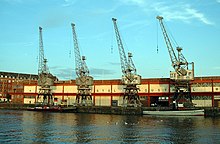

The most economically productive areas within the region are Bristol, the M4 corridor and south east Dorset, which are the areas with the best links to London. Bristol alone accounts for a quarter of the region's economy, with the surrounding areas of Gloucestershire, Somerset and Wiltshire accounting for a further quarter.[138]
Bristol's economy has been built on maritime trade, including the import of tobacco and the
The region's
Tourism is important in the region, and in 2003 the tourist sector contributed £4,928 million to the region's economy.[140] In 2001 the GVA of the hotel industry was £2,200 million, and the region had 13,800 hotels with 250,000 bed spaces.[138]
There are large differences in prosperity between the eastern parts of the region and the west. While Bristol is the second most affluent large city in England after London,[141] parts of Cornwall have among the lowest average incomes in Northern Europe.

The region's Manufacturing Advisory Service is on the A38 north of Gloucester at Twigworth,[142] and the UK Trade & Investment office is at the Leigh Court Business Centre in Abbots Leigh, North Somerset.[143]
Cornwall
Major companies in Cornwall include
Cornwall has become reliant on tourism, more so than the other counties of the South West. In 2010 Cornwall and the Isles of Scilly had the lowest GVA per head of any county or unitary authority in England.
Devon
The
XYZ Machine Tools is off the A38 close to the M5 bridge in Burlescombe near the Somerset boundary. The Donkey Sanctuary is in Sidmouth. Axminster Carpets makes carpets for every Wetherspoons pub.[citation needed]
All
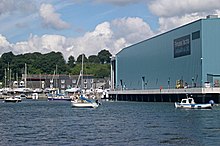
HMNB Devonport (HMS Drake, the largest naval base in western Europe) is in Plymouth. Toshiba had a large presence in Ernesettle, in the north of Plymouth, which was the second-largest employer after the Royal Navy, until they moved production of televisions to Kobierzyce in Poland in 2009; it made its last television at the site on 27 August 2009; Vispring (beds) is next to Kawasaki Precision Machinery. Snowbee make fishing tackle. 3 Commando Brigade is at Stonehouse Barracks. The Range (home and leisure) is on the B3432 in Estover east of Plymouth Airport; opposite is Fine Tubes and further east Barden make ball-bearings for the aerospace industry; on the furthest east of the industrial estate is Wrigley Company UK; its Extra brand is the second best-selling confectionery in the UK after Dairy Milk.[citation needed]

Dorset
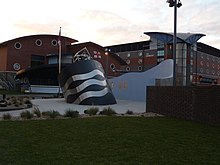
Gloucestershire
In Cheltenham are
Computer security firm

The
Somerset
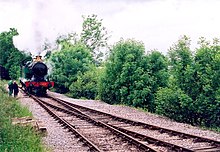

The
Thales Defence closed its radar site (former EMI Electronics) near Wookey Hole, in St Cuthbert Out. Thales Underwater Systems (former Plessey Marine) is at Abbas and Templecombe, Somerset, off the A357 towards Dorset in the Blackmore Vale, east of Yeovil. Commando Helicopter Force at Yeovilton operates Merlins and Wildcats (the upgraded version of the Lynx). Mulberry is based at Chilcompton on the B3139, north of Shepton Mallet, in the Mendips. Cox & Cox furnishings, is north of Frome in Berkley, Somerset off the A361. Fox Brothers make cloth in Wellington, and Relyon (part of Steinhoff International) make beds.
Italian defence contractor
Next to the
Wessex Water, Future plc, Buro Happold and Rotork are in Bath. Cadbury used to make Curly Wurly, Double Decker and Crunchie at the Somerdale Factory, Keynsham until Kraft closed the plant in March 2011 and moved production to Skarbimierz, Opole Voivodeship in Poland.[151]
Wiltshire

The headquarters of

Near the M4 Spittleborough Roundabout, close to
Triumph International UK is in Blunsdon St Andrew. On the A361 in Highworth north-east of Swindon, TS Tech make car seats for Honda, also with a site at the Renault Centre on the Rivermead industrial estate.[159]
Dyson is in Malmesbury, north of the M4.[160] Cotswold Outdoor (recommended supplier to the DofE Award and the Scout Association) is based at the Cotswold Airport near the Gloucestershire boundary south of Cirencester.

In the centre of the county are many military establishments, notably
Subdivisions
The region covers much of the historical area of Wessex (omitting only Hampshire and Berkshire), and all of the Celtic Kingdom of Dumnonia which comprised Cornwall, Devon, and parts of Somerset and Dorset. In terms of local government, it was divided after 1974 into Avon, Cornwall, Devon, Dorset, Gloucestershire, Somerset, and Wiltshire. Avon has since been abolished, and several mainly urban areas have become unitary authorities.
Local government
The official region consists of the following geographic counties and local government areas:
| Map | Ceremonial county | Non-metropolitan county or unitary authority | Non-metropolitan districts |
|---|---|---|---|
 |
Somerset | 1. Bath and North East Somerset UA | |
| 2. North Somerset UA | |||
| 10. Somerset UA | |||
| Bristol | 3. Bristol UA | ||
| Gloucestershire | 4. South Gloucestershire UA | ||
| 5. Gloucestershire CC | a) Forest of Dean
| ||
| Wiltshire | 6. Swindon UA
| ||
| 7. Wiltshire UA | |||
| Dorset | 8. Dorset UA
| ||
| 9. Bournemouth, Christchurch and Poole UA | |||
| Devon | 11. Devon CC | a) Exeter, b) East Devon, c) Mid Devon, d) North Devon, e) Torridge, f) West Devon, g) South Hams, h) Teignbridge | |
| 12. Torbay UA | |||
| 14. Plymouth UA | |||
| Cornwall | 15. Isles of Scilly sui generis UA | ||
| 13. Cornwall UA | |||
UA = unitary authority CC = county council
Eurostat NUTS
In the Eurostat Nomenclature of Territorial Units for Statistics (NUTS), South West England is a level-1 NUTS region, coded "UKK", which is subdivided as follows:
| NUTS 1 | Code | NUTS 2 | Code | NUTS 3 | Code |
|---|---|---|---|---|---|
| South West England | UKK | Gloucestershire, Wiltshire and Bristol/Bath area | UKK1 | Bristol | UKK11 |
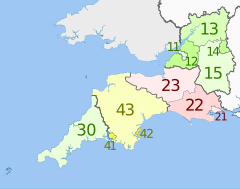
|
Bath and North East Somerset, North Somerset and South Gloucestershire | UKK12 | |||
| Gloucestershire CC | UKK13 | ||||
Swindon
|
UKK14 | ||||
| Wiltshire | UKK15 | ||||
| Dorset and Somerset | UKK2 | Bournemouth and Poole
|
UKK21 | ||
| Dorset CC | UKK22 | ||||
| Somerset | UKK23 | ||||
| Cornwall and Isles of Scilly | UKK3 | Cornwall and Isles of Scilly | UKK30 | ||
| Devon | UKK4 | Plymouth | UKK41 | ||
| Torbay | UKK42 | ||||
| Devon CC | UKK43 | ||||
South West Regional Assembly

Although referendums had been planned on whether elected assemblies should be set up in some of the regions, none was planned in the South West. The
Politics
This section needs to be updated. (March 2020) |
Currently the South West contains 55 seats in the House of Commons. The Conservatives hold 46 seats, Labour 6 and the Liberal Democrats 3.
South West England was one of the constituencies used for elections to the European Parliament until Brexit in 2020. From the 2004 election onwards, Gibraltar was included within the constituency for the purpose of elections to the European parliament only.
Elections

In the 2015 general election, there was a 0.7% swing from Labour to Conservative in the region. For the region's electorate, 46% voted Conservative, 18% voted Labour, Liberal Democrats 15%, UKIP 14% and Green 6%. The Conservatives gained 15 seats almost all of which were from the Liberal Democrats.
In 2017 the Conservatives lost 3 seats (Bristol North West, Plymouth Sutton and Devonport and Stroud) to Labour and 1 (Bath) to the Liberal Democrats. Labour increased their share of the vote by 11.4% while Ukip's vote collapsed. However the Conservatives still dominated the South West with 47 seats out of 55. In the 2019 general election, the Conservatives regained Stroud from Labour, bringing their total to 48.
| Date of election | Electorate | Con | Lab | Lib Dem | UKIP | Green | Others | Lead |
|---|---|---|---|---|---|---|---|---|
| 12 December 2019 | 3,053,377[172] | 52.8% | 23.4% | 18.2% | 0.0% | 3.8% | 1.9% | 29.4% |
| 8 June 2017 | 2,988,129[173] | 51.5% | 29.1% | 14.9% | 2.3% | 1.1% | 1.1% | 25.4% |
| 7 May 2015 | 2,836,294[174] | 46.5% | 17.7% | 15.1% | 13.6% | 5.9% | 1.2% | 28.8% |
| 6 May 2010 | 2,773,443[175] | 42.8% | 15.4% | 34.7% | 4.5% | 1.1% | 1.5% | 8.1% |
| 5 May 2005 | 2,553,315[176] | 38.6% | 22.8% | 32.6% | 3.7% | 1.3% | 1.0% | 6.0% |
| 7 June 2001 | 2,456,349[177] | 38.5% | 26.3% | 31.2% | 4.0% | 7.3% | ||
| 1 May 1997 | 2,778,046[178] | 36.7% | 26.4% | 31.1% | 5.5% | 5.6% | ||
Education
Schools
Secondary education
The South West has a below average rate of attainment in GCSE (and equivalent) examinations, with the lowest regional performance in England from 2009 to 2012.[179] In 2012, South Hams had the highest percentage of pupils achieving 5 or more GCSEs at grade A*-C at 86%, whilst Purbeck had the lowest at 70%.[180]
The region has an above average rate of attainment in A-Level (and equivalent) examinations, having outperformed the West Midlands, East Midlands, North East and London in 2012.[179]
Further education
There are around 29 further education colleges in the region.[181]
Higher education
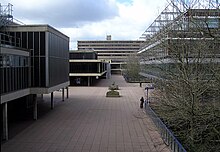
There are twelve universities in the region:
- Arts University Bournemouth[182]
- Bournemouth University[183]
- Bath Spa University[184]
- University of Bath[185]
- University of Bristol[186]
- Camborne School of Mines.[187] Part of the University of Exeter.
- University of Exeter[188]
- Falmouth University[189]
- University of Gloucestershire[190]
- The University of Law[191]
- University of Plymouth[192]
- Plymouth Marjon University[193]
- Royal Agricultural University[194]
- University of the West of England (UWE)[195]
There are also four higher education colleges. The region has the lowest number of people registered on higher education courses at FE colleges.
The University of Bristol receives the most total funding, according to Higher Education Funding Council for England figures for the 2006/2007 academic year, and the largest research grant—twice as big as any other in the region.[196] Bath has the next largest research grant, closely followed by Exeter. UWE and Plymouth get small research grants, but no other universities in the region receive much of a research grant. The University of Plymouth has the largest teaching grant.
Of the region's students (postgraduate and undergraduate), 50% are from the region, and around 40% from other regions. For full-time first degree students, 35% come from the region, around 22% are from
Local media

Television
- Spotlightregional programme.
- BBC West, based in Clifton in Bristol with the Points West regional programme.
- ITV West Country, based in Bristol (following the merger of ITV West and ITV Westcountry), with the ITV News West Country regional programme.
Parts of Wiltshire and Dorset, including the Swindon, Salisbury, Bournemouth, Poole, Dorchester and Weymouth areas, receive BBC South and ITV Meridian from Southampton.
Radio
BBC Local Radio services in the region include Cornwall, Devon, Somerset, Bristol, Wiltshire, and Gloucestershire, along with BBC Radio Solent's partial opt-out service for Dorset.
Commercial radio stations include:
- (Cornwall).
- Bauer, occupies a number of frequencies previously broadcast as part of The Breeze network. As on Heart, one regional weekday afternoon programme for the wider region is retained alongside local news and advertising. A version of GHR for Cornwall is provided on DAB and online. The former Spire FM (Salisbury), and Wessex FM (Dorchester) broadcast as part of Greatest Hits Radio Southin a similar manner.
- Bauer Radio also operates, as of September 2021:
- Radio Exe (formerly Exeter FM) is an independent locally-run commercial station for Exeter. The station expanded to serve Plymouth via the DAB digital radio platform in March 2022.[197]
- Licensed community radio services in the region include BCfm (Bristol), Soundart Radio (Totnes), FromeFM (Somerset), Gloucester FM, Phonic FM (Exeter), Somer Valley FM (north Somerset), Radio St Austell Bay (Cornwall), Ujima Radio (Bristol), The Voice (North Devon), East Devon Radio (formerly ExmouthAiR and Bay FM), and Cross Rhythms Plymouth.
National radio is transmitted from North Hessary Tor (west Devon) and Wenvoe (west of Cardiff).
Newspapers
Regional newspapers include the
.Sport
Rugby
In rugby union, the region has four Premiership Rugby teams: Bath Rugby, Bristol Bears, Exeter Chiefs and Gloucester Rugby.
In
Football
The region for two seasons until the conclusion of 2021–22 had no
Other teams play in the South divisions of the Southern League, at levels 7 and 8 of the league system. At levels 9 and 10, the Western League covers the whole region except the most eastern parts, while the Hellenic League extends into Gloucestershire and north Wiltshire, and the Wessex League has teams from east Dorset and south Wiltshire. Also at level 10, the South West Peninsula League has teams from Cornwall and Devon.
References
- ^ a b "Standard Area Measurements (Latest) for Administrative Areas in the United Kingdom (V2)". Open Geography Portal. Office for National Statistics. 5 April 2023. Retrieved 3 December 2023.
- ^ a b Park, Neil (21 December 2022). "Estimates of the population for the UK, England, Wales, Scotland and Northern Ireland". Office for National Statistics. Retrieved 25 August 2023.
- ^ Office for National Statistics. Retrieved 14 August 2023.
- ^ Fenton, Trevor (25 April 2023). "Regional gross value added (balanced) per head and income components". Office for National Statistics. Retrieved 14 August 2023.
- ^ Fenton, Trevor (25 April 2023). "Regional gross domestic product: all ITL regions". Office for National Statistics. Retrieved 15 August 2023.
- ^ "South West Regional Assembly, Draft Regional Spatial Strategy for the South West, para.1.1.1" (PDF). Archived (PDF) from the original on 4 March 2012. Retrieved 24 May 2012.
- ^ "South West Regional Assembly, Draft Regional Spatial Strategy for the South West, paras.1.1.3 and 7.2.1" (PDF). Archived (PDF) from the original on 4 March 2012. Retrieved 24 May 2012.
- ^ "Information Sheet 1E: The Dartmoor granite and associated igneous rocks" (PDF). Dartmoor National Park Authority. Archived (PDF) from the original on 15 November 2009. Retrieved 9 September 2009.
- ^ "High Willhays". Peakbagger.com. Archived from the original on 19 January 2012. Retrieved 9 September 2009.
- ^ "Direct From Dorset Producer case study". Western Gazette. This is Dorset. 16 January 2009. Retrieved 9 September 2009.
- ^ ISBN 0-948578-38-6.
- ISBN 0-86139-319-8.
- ^ "Dorset and East Devon Coast". UNESCO World Heritage Centre. 2001. Archived from the original on 24 October 2012. Retrieved 14 January 2007.
- ^ a b c d "South West England: climate". Met Office. Archived from the original on 5 June 2011. Retrieved 14 March 2010.
- ^ "South west faces temperature jump". BBC News. 19 June 2009. Retrieved 25 June 2009.
- ^ Sandford, Mark. "The Cornish Question: Devolution in the South-West Region" (PDF). UCL. Archived (PDF) from the original on 21 February 2011. Retrieved 12 February 2011.
- ^ "Regional Spaces: Spaces of Regionalism, Territory, Insurgent Politics and the English Question". Scribd.com. 31 March 2009. Archived from the original on 18 January 2012. Retrieved 24 May 2012.
- ^ Cornish Constitutional Convention. "Campaign for a Cornish Assembly". Cornishassembly.org. Archived from the original on 10 March 2012. Retrieved 24 May 2012.
- ^ "Population". South West RDA. Archived from the original on 4 September 2009. Retrieved 9 September 2009.
- ^ Harris, Nigel (2008). "Taking trains back to Tavistock". Rail. No. 590. Peterborough. pp. 40–45.
- ^ "UK storms destroy railway line and leave thousands without power". BBC News. 5 February 2014. Archived from the original on 5 February 2014. Retrieved 5 February 2014.
- ^ "Dawlish's storm-damaged railway line reopens". BBC News. 4 April 2014. Archived from the original on 4 April 2014. Retrieved 4 April 2014.
- ^ "Network Rail chooses Dawlish alternative route". BBC News. 10 February 2014. Archived from the original on 11 February 2014. Retrieved 10 February 2014.
- ^ "The LTP Process". Department for Transport. Archived from the original on 13 May 2010. Retrieved 26 September 2010.
- ^ "Bournemouth 2006–11 Local Transport Plan". Bournemouth Borough Council. Archived from the original on 15 April 2009. Retrieved 28 April 2009.
- ^ "Cornwall 2006–11 Local Transport Plan". Cornwall Council. Archived from the original on 4 August 2009. Retrieved 28 April 2009.
- ^ "Devon 2006–11 Local Transport Plan". Devon County Council. Archived from the original on 11 November 2009. Retrieved 28 April 2009.
- ^ "Dorset 2006–11 Local Transport Plan". Dorset County Council. Archived from the original on 11 October 2007. Retrieved 28 April 2009.
- ^ "Gloucestershire 2006–11 Local Transport Plan". Gloucestershire County Council. Archived from the original on 7 October 2007. Retrieved 28 April 2009.
- ^ "Plymouth 2006–11 Local Transport Plan". Plymouth City Council. Archived from the original on 26 July 2008. Retrieved 28 April 2009.
- Somerset County Council. Archivedfrom the original on 9 January 2009. Retrieved 28 April 2009.
- ^ "Swindon 2006–11 Local Transport Plan". Swindon Borough Council. Archived from the original on 1 May 2009. Retrieved 28 April 2009.
- ^ "Torbay 2006–11 Local Transport Plan". Torbay Borough Council. Archived from the original on 15 August 2007. Retrieved 28 April 2009.
- ^ "Wiltshire 2006–11 Local Transport Plan". Wiltshire Council. Archived from the original on 10 September 2010. Retrieved 28 April 2009.
- ^ "West of England Partnership 2011–26 Local Transport Plan". West of England Partnership. Archived from the original on 24 October 2010. Retrieved 28 April 2009.
- ^ "Mendip Hills An Archaeological Survey of the Area of Outstanding Natural Beauty" (PDF). Somerset County Council Archeological Projects. Archived (PDF) from the original on 16 May 2011. Retrieved 8 November 2010.
- ^ "Earliest British cemetery dated" (PDF). BBC News. Archived (PDF) from the original on 6 February 2007. Retrieved 27 January 2007.
- ^ ISBN 0-85033-461-6.
- ^ "Cheddar Man". RN-DS Partnership. Archived from the original on 11 June 2008. Retrieved 18 April 2008.
- ^ a b "Historical Monitoring in the Somerset Levels and Moors ESA 1987–1994" (PDF). DEFRA. Archived from the original (PDF) on 26 September 2007. Retrieved 10 June 2007.
- ISBN 978-0-946159-94-9.
- ^ "British Tribes". From Dot to Domesday. Archived from the original on 22 January 2008. Retrieved 2 December 2007.
- ^ "Britannia in the Ravenna Cosmography". cyberhome of Keith Fitzpatrick-Matthews. Archived from the original on 15 March 2007. Retrieved 2 December 2007.
- ^ [1] Archived 17 February 2017 at the Wayback Machine Language in the British Isles, Peter Trudgill, 1984
- ^ Rajan, Amal (24 August 2007). "Around a county in 40 facts: A (very) brief history of Somerset". Independent on Sunday. London. Archived from the original on 14 February 2009. Retrieved 21 October 2007.
- ISBN 0-340-20116-9.
- ^ "Romano-British Somerset". Somerset County Council: History of Somerset. Archived from the original on 17 October 2012. Retrieved 29 October 2006.
- ^ "Roman Baths Treatment Centre". Images of England. Archived from the original on 15 June 2009. Retrieved 15 November 2006.
- ^ ISBN 0-9548832-0-9.
- ^ Hucker, Ernest (1997). Chew Stoke Recalled in Old Photographs. Ernest Hucker.
- ^ "The West Bagborough Hoard". Newsletter Spring/Summer 2003. Somerset Archaeological and Natural History Society. Archived from the original on 17 July 2011. Retrieved 10 July 2010.
- ^ "Huge Roman coin find for hobbyist". BBC News. 8 July 2010. Retrieved 8 July 2010.
- ^ Booth, Anna (8 July 2010). "The Frome Hoard". Portable Antiquities Scheme. Archived from the original on 12 July 2010. Retrieved 8 July 2010.
- ^ Pearce, Susan M. (1978), The Kingdom of Dumnonia: Studies in History and Tradition in South-Western Britain A.D. 350–1150 Padstow: Lodenek Press.
- ISBN 978-0-19-280139-5.
- ISBN 1-84212-477-3.
- ^ The Anglo-Saxon Chronicle, 501–97 AD Archived 10 November 2006 at the Wayback Machine.
- ^ The Anglo-Saxon Chronicle, 645–56 AD Archived 12 December 2007 at the Wayback Machine
- ^ The Anglo-Saxon Chronicle, 658–75 AD Archived 12 December 2007 at the Wayback Machine
- ^ The Victoria History of the County of Somerset, Vol 1 (1906)South West England
- ^ "Roman Times". Britannia. Archived from the original on 12 November 2006. Retrieved 29 October 2006.
- ISBN 1-902007-01-8.
- ISBN 0-907864-97-X.
- ^ Charles Oman. "History of Taunton Castle in Somerset". Britannia castles. Archived from the original on 31 May 2008. Retrieved 21 November 2007.
- ISBN 978-1-903356-57-9.. However, Hingston Down in Devon has also been proposed as the site.
- ISBN 0-226-16779-8.
- ^ Payton, Philip (1996). Cornwall. Fowey: Alexander Associates
- ^ Todd, Malcolm The South West to AD 1000. London, 1987; p. 289
- ^ a b Farr, Grahame (1954). Somerset Harbours. London: Christopher Johnson. pp. 125–137.
- ^ "Replicas of the Alfred Jewel". The Anglo Saxon Index, Trinity College, Cambridge. Archived from the original on 2 November 2007. Retrieved 18 September 2007.
- ^ "Local History". North Petherton. Archived from the original on 30 June 2007. Retrieved 19 November 2007.
- ^ Rahtz, Philip. "The Saxon and Medieval Palaces at Cheddar, Somerset-an Interim Report of Excavations in I 960-62" (PDF). Archaeology Data Service. Archived (PDF) from the original on 10 April 2008. Retrieved 31 March 2008.
- ISBN 0-521-53777-0. Archivedfrom the original on 18 February 2017. Retrieved 17 March 2016.
- J. A. Giles(London, 1847). Medieval and Classical Literature Library Release #17. Retrieved 4 May 2018.
- ISBN 0-631-15565-1.
- ISBN 0-520-01671-8.
- ^ "Eadmund". Archontology.org. Archived from the original on 27 September 2010. Retrieved 5 July 2010.
- ^ "Saxon Times". Britannia. Archived from the original on 12 November 2006. Retrieved 29 October 2006.
- ^ "Bridgwater Castle, Bridgwater". Somerset Historic Environment Record. Somerset County Council. Archived from the original on 3 October 2016. Retrieved 12 October 2008.
- ^ "The history of Exmoor". Exmoor National Park. Archived from the original on 29 July 2013. Retrieved 29 November 2007.
- ISBN 1-86077-363-X. Chapter 8: "The Medieval Port of Bridgwater".
- ISBN 0-900131-15-2.
- ISBN 0-7509-0192-6.
- ISBN 0-7509-0192-6.
- ISBN 0-7091-5435-6.
- ^ Croxton, Derek (1990–1991). "The Cabot Dilemma: John Cabot's 1497 Voyage & the Limits of Historiography". Essays in History. 33. Virginia: Corcoran Department of History at the University of Virginia. Archived from the original on 28 February 2009. Retrieved 16 March 2009.
- ^ "Largest towns in England in 1334". Love my town. Archived from the original on 11 May 2011. Retrieved 10 March 2007.
- ^ a b "Bristol". Fortified Places. Archived from the original on 20 March 2007. Retrieved 24 March 2007.
- ISBN 978-0-77344-714-1.
- ISBN 0-19-826924-2.
- ISBN 0-86012-289-1.
- S2CID 162954069.
- ^ Bryant, Edward; Haslett, Simon (2002). "Was the AD 1607 coastal flooding event in the Severn estuary and Bristol channel due to a Tsunami?". Archaeology in the Severn Estuary. 13: 163–167.
- ^ Bryant, Edward; Haslett, Simon (2004). "The AD 1607 Coastal Flood in the Bristol Channel and Severn Estuary: Historical Records from Devon and Cornwall (UK)". Archaeology in the Severn Estuary. 15: 81–89.
- ^ "Historic Buildings of Shepton Mallet". Shepton Mallet Town Council. Archived from the original on 18 January 2012. Retrieved 30 August 2007.
- ISBN 0-9511470-2-1.
- ^ Rodgers, Colonel H.C.B. (1968). Battles and Generals of the Civil Wars. Seeley Service & Co.
- ^ "Taunton's History". Taunton Town Centre!. Archived from the original on 3 June 2007. Retrieved 21 November 2007.
- ^ "The Civil War in Somerset". Somerset County Council: History of Somerset. Archived from the original on 25 September 2006. Retrieved 29 October 2006.
- ^ "The Monmouth rebellion and the bloody assize". Somerset County Council. Archived from the original on 29 August 2007. Retrieved 11 February 2008.
- ^ "History of Bridgwater". Bridgwater. Archived from the original on 12 November 2007. Retrieved 21 October 2007.
- ^ "Tudor & Stuart Times". Britannia. Archived from the original on 12 November 2006. Retrieved 29 October 2006.
- ^ J. Childs, The Army, James II, and the Glorious Revolution (Manchester, 1980)
- ^ "Devonport". Royal Navy. Archived from the original on 22 September 2013. Retrieved 17 July 2012.
- ISBN 0-415-19399-0.
- ^ "Chard was there first". Daily Telegraph. London. 7 October 2006. Archived from the original on 29 October 2006. Retrieved 17 October 2008.
- ^ "North Petherton". British History Online. Archived from the original on 25 May 2011. Retrieved 19 November 2007.
- ISBN 978-1-85260-049-5.
- ISBN 978-0-7110-2063-4.
- ^ "City of Bristol (Portishead Docks) Act". Office of Public Sector Information. 1992. Archived from the original on 25 September 2008. Retrieved 1 December 2009.
- ^ Slapton Line: Slapton Monument Rededication Archived 31 May 2016 at the Wayback Machine – Devon County Council – Devon.gov.uk – Updated 9 March 2007
- ^ Stokes, Paul. "Veterans honour 749 who died in D-Day rehearsal" – The Daily Telegraph – London – 29 April 1994
- ^ John Penny MA; The Luftwaffe over the Bristol area 1940–44 Archived 11 May 2011 at the Wayback Machine Retrieved 14 July 2008
- ISBN 1-85074-718-0
- ^ "Taunton Stop Line". Pillboxes Somerset. Archived from the original on 28 October 2007. Retrieved 25 October 2007.
- ^ "The Mendip Society website". Archived from the original on 5 February 2007. Retrieved 17 February 2007.
- ^ "Hinkley A: 1965". BBC Somerset. BBC. Archived from the original on 18 July 2006. Retrieved 5 July 2008.
- ^ "New dawn for UK nuclear power". World Nuclear News. 24 September 2008. Archived from the original on 25 September 2008. Retrieved 25 September 2008.
- ^ "Nuclear energy: British Energy facts". The Daily Telegraph. London. 24 September 2008. Archived from the original on 27 September 2008. Retrieved 25 September 2008.
- ^ United Kingdom Census 2001 (2001). "Key Figures for 2001 Census: Census Area Statistics: Area: Bath and North East Somerset". statistics.gov.uk. Archived from the original on 2 February 2008. Retrieved 12 December 2007.
{{cite web}}: CS1 maint: numeric names: authors list (link) - ^ "Census 2001 results show South West is fastest growing region". 2001 Census. Office for National Statistics. Archived from the original on 15 September 2008. Retrieved 8 August 2008.
- ^ "Local statistics - Office for National Statistics". neighbourhood.statistics.gov.uk. Archived from the original on 2 April 2015. Retrieved 2 December 2014.
- Office for National Statistics. Retrieved 12 August 2020.
- ^ As UK Census data past 2001 is unavailable through the ONS website, it has been recommended to use archival census collection websites. Data is from the UK Data Service, 1991 Census on Ethnic Data for England (Table 6)
- ^ "Office of National Statistics; 2001 Census Key Statistics". webarchive.nationalarchives.gov.uk. Retrieved 24 June 2022.
- ^ "2011 Census: Ethnic Group, local authorities in England and Wales". webarchive.nationalarchives.gov.uk. Retrieved 24 June 2022.
- ^ "Ethnic group - Office for National Statistics". www.ons.gov.uk. Retrieved 29 November 2022.
- ^ "Disappointment as teen pregnancies increase". This is South Devon. 20 June 2009. Retrieved 9 September 2009.
- ^ "Deprivation indices 2007" (PDF). Archived from the original (PDF) on 9 June 2012. Retrieved 24 May 2012.
- ^ "Index of Multiple Deprivation (IMD) 2007". Data.gov. 9 February 2010. Archived from the original on 27 January 2013. Retrieved 9 February 2013.
- ^ "Changing Regional Economies — South West" (PDF). Office for National Statistics. Archived (PDF) from the original on 16 September 2012. Retrieved 17 July 2012.
- ^ the South West GovOf through time | Population Statistics | Total Population Archived 12 October 2012 at the Wayback Machine. Visionofbritain.org.uk. Retrieved on 14 March 2021
- ^ Jackson, Kenneth (1953). Language and History in Early Britain. Edinburgh: Edinburgh University Press.
- ^ Payton, Philip Cornwall. Fowey: Alexander Associates (1996).
- ^ "The Cornish Language". Kernowek. Archived from the original on 19 September 2012. Retrieved 9 February 2013.
- ^ Gover, J.; Mawer, A. and Stenton, F. M. Place-Names of Devon, 1932
- ^ a b c d "Portrait of South West England: Economy". Eurostat & Office for National Statistics, 2004. Archived from the original on 11 March 2007. Retrieved 14 April 2006.
- ^ "Economy Module". Economy.swo.org.uk. Archived from the original on 25 May 2012. Retrieved 24 May 2012.
- ^ "Tourism contribution figures". South West Regional Development Agency. Archived from the original on 12 June 2007. Retrieved 16 June 2007.
- ^ Office of the Deputy Prime Minister, 2004. "Competitive European Cities: Where do the Core Cities stand? Urban Research Summary 13 Archived 30 October 2005 at the Wayback Machine." Page 12 (PDF)
- ^ "Manufacturing Advisory Service". Mas.bis.gov.uk. Archived from the original on 27 December 2011. Retrieved 24 May 2012.
- ^ "UKTI". UKTI. Archived from the original on 15 June 2012. Retrieved 24 May 2012.
- ^ "Regional, sub-regional and local Gross Value Added 2010" (PDF). Statistical Bulletin. Office for national Statistics. 14 December 2011. p. 10. Archived (PDF) from the original on 4 May 2012. Retrieved 9 June 2012.
- ^ "The changing state of the south west 2012". South West Observatory. Archived from the original on 28 April 2012. Retrieved 17 July 2012.
- ^ "Objective One in Cornwall and the Isles of Scilly". The Partnership Office for Cornwall and the Isles of Scilly. Archived from the original on 1 July 2012. Retrieved 9 June 2012.
- ^ "Local Authority & County Analysis 2006–2010". GBTS England LA & County & Towns 2006–2010. VisitEngland. September 2011. p. 5. Retrieved 9 June 2012.
- ^ "Objective One in Cornwall and the Isles of Scilly". www.objectiveone.com. Archived from the original on 1 July 2012. Retrieved 7 June 2012.
- ^ Richard Norton-Taylor (10 June 2003). "The Doughnut, the less secretive weapon in the fight against international terrorism". The Guardian. Archived from the original on 19 December 2013. Retrieved 15 December 2013.
- ^ V&A (2022). "V&A · The history of Glastonbury Festival". Victoria and Albert Museum. Retrieved 22 October 2022.
- ^ Kelly, Chris (14 January 2011). "Broken chocolate factory pledge devastates Keynsham". BBC News. Archived from the original on 28 May 2011. Retrieved 21 October 2017.
- ^ "Locations of our head offices". Nationawide. Archived from the original on 30 December 2017. Retrieved 30 December 2017.
- ^ "Details of our Swindon and London Offices". BCS. Archived from the original on 30 December 2017. Retrieved 30 December 2017.
- ^ "Swindon National Office". Historic England. Archived from the original on 30 December 2017. Retrieved 30 December 2017.
- ^ "Heelis". National Trust. Archived from the original on 30 December 2017. Retrieved 30 December 2017.
- ^ "Mini Plant Swindon". MINI. Archived from the original on 14 November 2017. Retrieved 30 December 2017.
- ^ "Honda boosts UK investment". BBC. Archived from the original on 31 August 2007. Retrieved 30 December 2017.
- ^ "Head Office – Swindon". WH Smith. Archived from the original on 30 December 2017. Retrieved 30 December 2017.
- ^ "T.S. Tech Ltd". TS Tech. Archived from the original on 30 December 2017. Retrieved 30 December 2017.
- ^ "Malmesbury". Dyson. Archived from the original on 30 December 2017. Retrieved 30 December 2017.
- ^ "Our History". Apetito. Archived from the original on 30 December 2017. Retrieved 30 December 2017.
- ^ "Contact Us". Danone. Archived from the original on 30 December 2017. Retrieved 30 December 2017.
- ^ "Visit Us". Wadworths. Archived from the original on 30 December 2017. Retrieved 30 December 2017.
- ^ "Contact Information". Naim. 3 September 2014. Archived from the original on 30 December 2017. Retrieved 30 December 2017.
- ^ "dstl". dstl. Archived from the original on 29 December 2017. Retrieved 30 December 2017.
- ^ "Contact Information". Knorr-Bremse. Archived from the original on 30 December 2017. Retrieved 30 December 2017.
- ^ "Where We Operate". Avon Rubber. Archived from the original on 30 December 2017. Retrieved 30 December 2017.
- ^ "Contact". Wincanton PLC. Archived from the original on 30 December 2017. Retrieved 30 December 2017.
- ^ Armstrong, Julie (8 May 2013). "£1.8bn takeover of Invensys Rail in Chippenham concluded". Gazette and Herald. Archived from the original on 30 December 2017. Retrieved 30 December 2017.
- ^ "Salisbury Plain Training Area (SPTA)". Army. Archived from the original on 30 December 2017. Retrieved 30 December 2017.
- ^ SW Councils (17 May 2012). "Strategic Leaders' Board". Swcouncils.gov.uk. Archived from the original on 8 February 2011. Retrieved 24 May 2012.
- ^ "GE2019 - Constituency Results". Britain Elects. 12 December 2019. Retrieved 23 April 2020.
- ^ "GE2017 - Constituency Results". Britain Elects. 9 June 2017. Retrieved 5 March 2019.
- ^ Hawkins, Oliver; Keen, Richard; Nakatudde, Nambassa; Ayres, Steven; Baker, Carl; Harker, Rachael; Bolton, Paul; Johnston, Neil; Cracknell, Richard (28 July 2015). "General Election 2015". House of Commons Library. Archived from the original on 28 September 2018. Retrieved 5 March 2019.
- ^ "Election 2010 Results South West". BBC News. Archived from the original on 29 August 2017. Retrieved 5 March 2019.
- ^ "Election 2005 Results South West". BBC News. Archived from the original on 4 February 2009. Retrieved 5 March 2019.
- ^ "Election 2001 Results South West". BBC News. Archived from the original on 19 November 2015. Retrieved 3 March 2019.
- ^ "GENERAL ELECTION RESULTS, 1 MAY 1997" (PDF). Parliament of the United Kingdom. Archived (PDF) from the original on 4 December 2016. Retrieved 3 March 2019.
- ^ a b Education and Skills In Your Area - England Archived 12 February 2014 at the Wayback Machine DfE
- ^ Education and Skills In Your Area - South West Region Archived 21 February 2014 at the Wayback Machine DfE
- ^ "Further Education Finder". findfe.com. Archived from the original on 2 February 2014. Retrieved 20 January 2014.
- ^ "Arts University Bournemouth". Arts University Bournemouth. Archived from the original on 15 May 2018. Retrieved 2 January 2016.
- ^ "Bournemouth University". Bournemouth University. Archived from the original on 26 January 2015. Retrieved 2 January 2016.
- ^ "Bath Spa University". Bath Spa University. Archived from the original on 9 December 2007. Retrieved 2 January 2016.
- ^ "University of Bath". University of Bath. Archived from the original on 1 January 2016. Retrieved 2 January 2016.
- ^ "University of Bristol". University of Bristol. Archived from the original on 1 January 2016. Retrieved 2 January 2016.
- ^ "Camborne School of Mines". Retrieved 23 April 2020.
- ^ "University of Exeter". University of Exeter. Archived from the original on 31 December 2015. Retrieved 2 January 2016.
- ^ "Falmouth University". Falmouth University. Archived from the original on 2 January 2016. Retrieved 2 January 2016.
- ^ "University of Gloucestershire". University of Gloucestershire. Archived from the original on 28 November 2004. Retrieved 2 January 2016.
- ^ "University of Law". University of Law. Archived from the original on 29 December 2015. Retrieved 2 January 2016.
- ^ "Plymouth University". Plymouth University. Archived from the original on 10 January 2016. Retrieved 2 January 2016.
- ^ "University of St Mark & St John". University of St Mark & St John. Archived from the original on 26 December 2015. Retrieved 2 January 2016.
- ^ "Royal Agricultural University". Royal Agricultural University. Archived from the original on 26 December 2015. Retrieved 2 January 2016.
- ^ "University of the West of England". University of the West of England. Archived from the original on 2 January 2016. Retrieved 2 January 2016.
- ^ "South West Region" (PDF). Regional profiles of higher education 2007. HEFCE. Archived (PDF) from the original on 12 November 2009. Retrieved 31 March 2010.
- ^ Radio Exe, 2022-03-04
- ^ Richards, Alex (26 July 2020). "Premier League relegation: Watford and Bournemouth down as Aston Villa safe after final day". Mirror. Retrieved 29 November 2020.
- ^ ""Forest Green Rovers: The village team that reached the English Football League", BBC News, 15 May 2017". BBC Sport. Archived from the original on 14 January 2018. Retrieved 14 February 2018.
Further reading
- Brayshay, Mark (1986). Topographical Writers in South-West England. Exeter: University of Exeter Press. ISBN 0-85989-424-X.
- Dunning, Robert (1983). A History of Somerset. Chichester: Phillimore & Co. ISBN 0-85033-461-6.
- Higham, Robert (1989). Landscape and Townscape in the South-West. Exeter: University of Exeter Press. ISBN 0-85989-309-X.
- Stansfield-Cudworth, R.E. (2009). Political Elites in South-West England, 1450–1500. ISBN 978-0-77344-714-1.
- Pearce, Susan (2004). South-Western Britain in the Early Middle Ages. London: Leicester University Press. ISBN 0-71850-055-5.
- Todd, Malcolm (1987). The South West to AD 1000. London: Routledge. ISBN 0-58249-274-2.
